42 examples of nutrient claims on food labels
Nutrient Claims on Food Labels - Food Smart Colorado "Low fat" and "High fiber" are both examples of nutrient content claims. These types of claims usually appear on the front of a package and are regulated by the Food and Drug Administration (FDA). The FDA requires that the industry follow guidelines when making these claims. Common Nutrient Claims and Descriptors Did You Know? Understanding Food Labels - Nutrition: Science and Everyday Application ... As an example of an authorized health claim, a food that is low in sodium (per the FDA's definition of less than 140 mg per serving) can include the following claim on their packaging: "Diets low in sodium may reduce the risk of high blood pressure, a disease associated with many factors." 1
Understanding Food Labels | The Nutrition Source | Harvard T.H. The FDA has approved 12 health claims on food labels such as the relationship between calcium and osteoporosis; sodium and hypertension; fiber-containing grains, fruits and vegetables and cancer; and folic acid and neural tube defects. However, just because a food contains a specific nutrient that is associated with a decreased risk of disease does not necessarily make …

Examples of nutrient claims on food labels
Nutrient Content Claim vs Health Claim - LabelCalc Nutrient content claims, which are commonly used on food labels, either refer to the amount of a nutrient in a product or compare the levels of a nutrient in that food to a similar reference food. When referring to the amount of a nutrient in a product, words such as "low," "free," and "high" are often used. Label Claims for Conventional Foods and Dietary Supplements 07.03.2022 · Among the claims that can be used on food and dietary supplement labels are three categories of claims that are defined by statute and/or FDA regulations: health claims, nutrient content claims ... Food Packaging Claims | American Heart Association "Reduced" or "Less" mean the food has 25% less of a specific nutrient than the regular product. "More," "Fortified," "Enriched," "Added," "Extra," or "Plus" means the food has 10% or more of the Daily Value (DV) than the regular product. May only be used for vitamins, minerals, protein, dietary fiber, and potassium.
Examples of nutrient claims on food labels. Nutrition claims - Canada.ca Nutrition claims - Canada.ca Source, such as source of fibre High or good source, such as high in vitamin A or good source of iron Very high or excellent source, such as excellent source of calcium Free, such as sodium free or trans fat free Low, such as low fat Reduced, such as reduced in Calories How Can I Eat More Nutrient-Dense Foods? - American Heart … 02.11.2021 · Learn what nutrient density means and how you can eat more nutritious foods to build a healthy diet pattern and eating habits. Forget so-called superfoods. Including more of these healthy foods in your diet can help you eat better, lose weight, reduce calories, have more energy and prevent heart disease and stroke. 4 Examples of Marketing Through Nutrition Labels | Fooducate If a nutrition claim is made on the packaging of a food ('Good Source of Fiber' is an example), and that food exceeds the threshold level for any of four specific nutrients, a disclosure statement must appear next to the nutrition claim. The four nutrients and their threshold levels (per serving) are: Fat-13g, Saturated Fat-4g ... Food Compass is a nutrient profiling system using expanded ... 14.10.2021 · A nutrient profiling system is developed to incorporate 54 attributes across 9 domains, bringing together a broad and unique range of food characteristics and uniform scoring principles. The Food ...
Label Claims for Food and Dietary Supplement - LBS RCS.COM The Nutrition Labeling and Education Act of 1990 (NLEA) provides for the use in food labeling of health claims that characterize a relationship between a food, a food component, or dietary ingredient and risk of a disease (for example, "adequate calcium throughout life may reduce the risk of osteoporosis"), provided the claims meet certain criteria and are authorized by an FDA regulation. Nutrient content claim examples - Nutrient content claims: reference ... Nutrient content claim example - fibre claims Example - High source of fibre The following claim appears on a box of 6 muffins: "High source of wheat bran and oat bran". Each muffin contains 1.5 g of fibre from wheat bran and 3.5 g of fibre from oat bran per serving of stated size of 90 g. 8 misleading food marketing labels | AGDAILY It turns out that many, if not most of them, really aren't. Here are 8 of the most common misleading food marketing claims: 1. No nitrites or nitrates added. Although this particular labeling regulation may be changing soon, you may have noticed the "No Nitrites or Nitrates Added" label on processed meat products, such as deli meats and ... Nutrient Claims on Food Labels - Truly Good Foods Nutrient Claims on Food Labels July 19, 2018 Nutrient claims describe the content of a food, including the amount of nutrients, calories, cholesterol or fiber, but not in exact amounts. Usually on the front of the food label, the nutrient claim provides a quick comparison between similar products.
In Pictures: 29 Foods With "Health Claims" That Are Deceiving You And ... A. It's a little scary that food companies can put deceptive labels on foods we already know are unhealthy. I've first-hand see people say "oh, look, it's all natural!" and then never question the food from then on out.-Agreed. B. The whole "all natural thing." People think if a label says it's natural, it's fine to eat. Understanding Food Labels | The Nutrition Source | Harvard T.H. Chan ... For example, a bag of potato chips may advertise that it has 40% less fat and is cholesterol-free, suggesting it is a "healthy" food, when in reality even a "healthier" potato chip is still a high-calorie ultra-processed food offering little nutrition. Some terms are not yet regulated by the FDA such as " natural " or "multigrain." How to Understand and Use the Nutrition Facts Label | FDA - U.S. Food … 25.02.2022 · Understand Nutrient Content Claims: Use %DV to help distinguish one claim from another, such as "light,” “low,” and “reduced.” Simply compare %DVs in each food product to see which one ... 5 Understanding Food Labels and Health Claims - Maricopa There are three levels of health claims: A health claim is supported by scientific evidence. An example is "reduces heart disease." A qualified claim has supportive evidence, which is NOT definitely proven with scientific evidence. There is evidence to SUGGEST a health benefit, but there is no scientific evidence.
Label Claims for Conventional Foods and Dietary Supplements Examples include simple percentage statements such as "40% omega-3 fatty acids, 10 mg per capsule," and comparative percentage claims, e.g., "twice the omega-3 fatty acids per capsule (80 mg) as in...
Nutrition content claims and health claims - Food Standards For example: 'calcium for healthy bones and teeth'. These claims are either based on one of the more than 200 pre-approved food-health relationships in the Standard, or a food-health relationship self-substantiated by the food business using the scientific method set out in the Standard.
Information on Nutrition and Health Claims - FSAI Nutrition claims on protein, monounsaturated, polyunsaturated and unsaturated fat. These nutrition claims require the use of a conversion factor. This is outlined in detail on page 8. Practical examples on how to follow the step by step process to make permitted nutrition and health claims on food products are outlined in Annex 1 (pages 29 – 35)
Nutrition and Health Claims in Food Labelling | Eufic Nutrition claims, which state, suggest or imply that a food has particular beneficial properties due to its composition (regarding energy or a particular nutrient ). Examples of this type of claim will be: 'source of', 'free of', 'high', 'low' or 'reduced' in calories or a particular nutrient.
Decoding the Nutrition Label: Health Claims and Nutrient Content Claims ... Below are examples of health claims you may find on some foods: A healthy diet rich in vegetables and fruit may help reduce the risk of some types of cancer. A healthy diet low in saturated and trans fat may reduce the risk of heart disease.
13 Misleading Food Label Claims and How Not to Be Tricked - Sentient Media 9. Label Says "Multigrain". Though the term " multigrain " may elicit a vision of multiple healthy whole grains all being put in one product, this is likely not the case. The term simply means that a variety of grains were used in the food; most, if not all, of these grains are likely refined. 10.
Nutrition and health claims | Business Companion state the amount per 100 g of the substance in the same field of vision as the nutrition declaration. claims that suggest that health could be affected by not consuming the food. claims that refer to the rate or amount of weight loss, including: statements (for example, 'Lose two stone in two weeks')
Proteins | Nutrition.gov Nutrient Lists from Standard Reference Legacy (2018) USDA , National Agricultural Library , Food and Nutrition Information Center This page provides lists of which foods have the most and least content of specific nutrients.
Nutrition and health claims on labels and in food advertising Most of the permitted health claims relate to a specific ingredient or nutrient; some claims relate to a food, for example "dried plums contribute to normal bowel function" or "sugar-free chewing...
Food Labels Guide & Examples | How to Read Nutrition Labels - Video ... A glass of orange juice, for instance, may contain a significant amount of Vitamin C while a chocolate bar may not contain any, so Vitamin C would not be listed on the chocolate bar's food label....
Making Sense of Food Labels | ADA - American Diabetes … Trying to figure out nutritional information on labels and packaging isn’t easy. The good news is that we can help. These food labels are especially helpful if you use carb counting to plan your meals! If you get tripped up on food content claims, you’re not alone. Fat free vs. low fat vs. reduced fat. Low cholesterol vs. reduced ...
Nutrient Claims on Food Labels - Clemson University The label on a can of pears says there is "no added sugar." The words on a milk carton boast that it is "high in calcium." Certain breakfast cereals claim to be "high in fiber." "Lite" salad dressing and cookies with "fewer calories" also catch your eye. These are all nutrient content claims.
Nutrient content claims - Canadian Food Inspection Agency Comparative nutrient content claims. Conditions for use of comparative nutrient content claims; Comparative claims for vitamin and mineral nutrients; Reformulated products and similar reference foods; Example: steps for evaluating "reduced in fat" Nutrient content claims on foods intended solely for children under two years of age. Advertising ...
Factual Food Labels: Health Claims - University of Texas at Austin The terms that are used in this type of label is "free," "reduced," "high," and "low." These type of claims are only applicable to nutrients that have a % daily value established such as saturated fat, added sugars, and vitamins and minerals. An example of this type of claim is "low/less sugar."
Health claims | EFSA - European Food Safety Authority 15.11.2018 · An increasing number of foods sold in the EU bear nutrition and health claims. A nutrition claim states or suggests that a food has beneficial nutritional properties, such as “low fat”, “no added sugar” and “high in fibre”. A health claim is any statement on labels, advertising or other marketing products that health benefits can result from consuming a given food, for …
Label Claims for Food & Dietary Supplements | FDA Types of Claims Definitions, Guidance, Regulatory Information, and Permitted Claims FDA Modernization Act of 1997 (FDAMA) Health and Nutrient Content Claims Health Claims That Meet Significant...
Introduction to Food Product Claims — FDA Reader Examples of a Structure/Function Claim: "Calcium builds strong bones" "Fiber maintains bowel regularity" "Antioxidants maintain cell integrity" Conventional food producers do not need to notify the FDA about structure/function claims or make disclaimers associated with these claims on their product labels.
Food Label Claims: What You Can and Can't Trust - WebMD For example, a label could say that getting enough calcium throughout your life, and having a balanced diet, may lower your chances of getting osteoporosis. Structure/function claims. These...
Nutrient function claims - Health claims on food labels - Food labels ... Nutrient function claims are not made for a food per se; they may only be made respecting the energy value or nutrients in a food. For example, the nutrient function claim "Milk helps build strong bones and teeth" is unacceptable, because a nutrient function claim refers to the nutritional function of energy or a nutrient (e.g., calcium) in a ...
Food Labels | Nutrition.gov What's New with the Nutrition Facts Label. HHS, Food and Drug Administration. The U.S. Food and Drug Administration (FDA) has updated the Nutrition Facts label on packaged foods and beverages with a fresh design that will make it easier for you to make informed food choices that contribute to lifelong healthy eating habits. What's in a Name?
Food Packaging Claims | American Heart Association "Reduced" or "Less" mean the food has 25% less of a specific nutrient than the regular product. "More," "Fortified," "Enriched," "Added," "Extra," or "Plus" means the food has 10% or more of the Daily Value (DV) than the regular product. May only be used for vitamins, minerals, protein, dietary fiber, and potassium.
Label Claims for Conventional Foods and Dietary Supplements 07.03.2022 · Among the claims that can be used on food and dietary supplement labels are three categories of claims that are defined by statute and/or FDA regulations: health claims, nutrient content claims ...
Nutrient Content Claim vs Health Claim - LabelCalc Nutrient content claims, which are commonly used on food labels, either refer to the amount of a nutrient in a product or compare the levels of a nutrient in that food to a similar reference food. When referring to the amount of a nutrient in a product, words such as "low," "free," and "high" are often used.



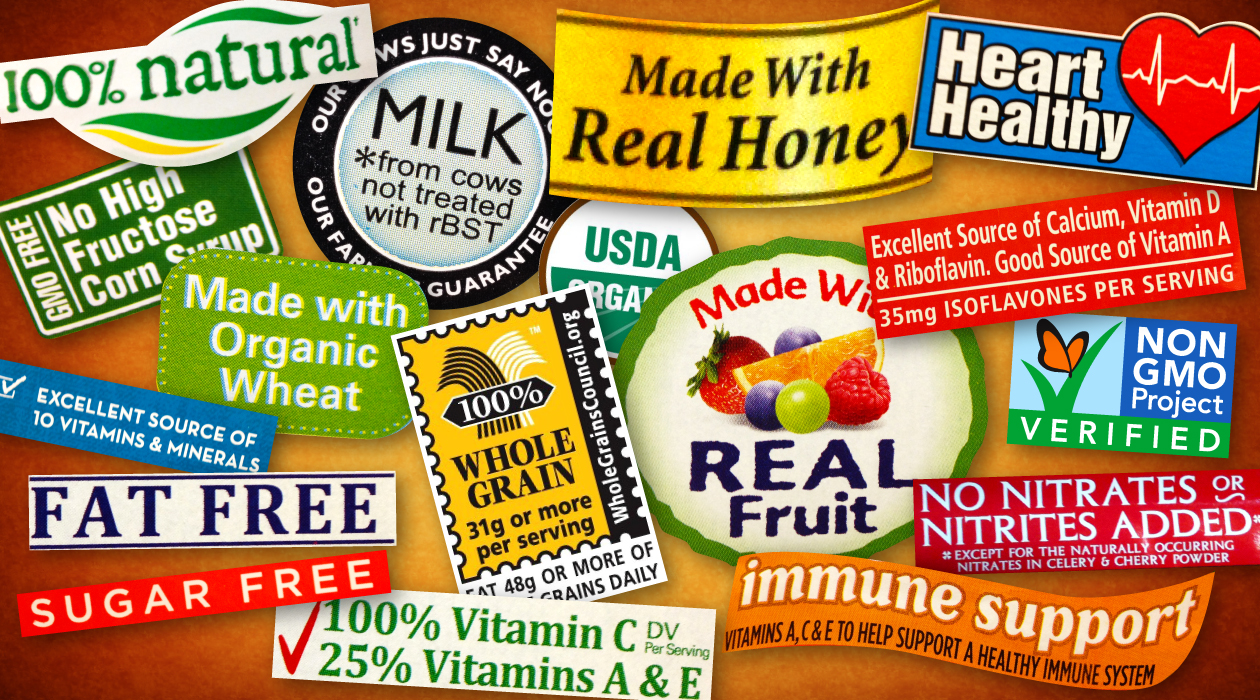
![PDF] Are nutrient content claims always effective for food ...](https://d3i71xaburhd42.cloudfront.net/bf9a8d12d02bf7eb9ce5ff6bb423d90e25263aca/27-Table2.2-1.png)

:no_upscale()/cdn.vox-cdn.com/uploads/chorus_asset/file/3648106/quaker-oats-heartlabel.0.jpg)
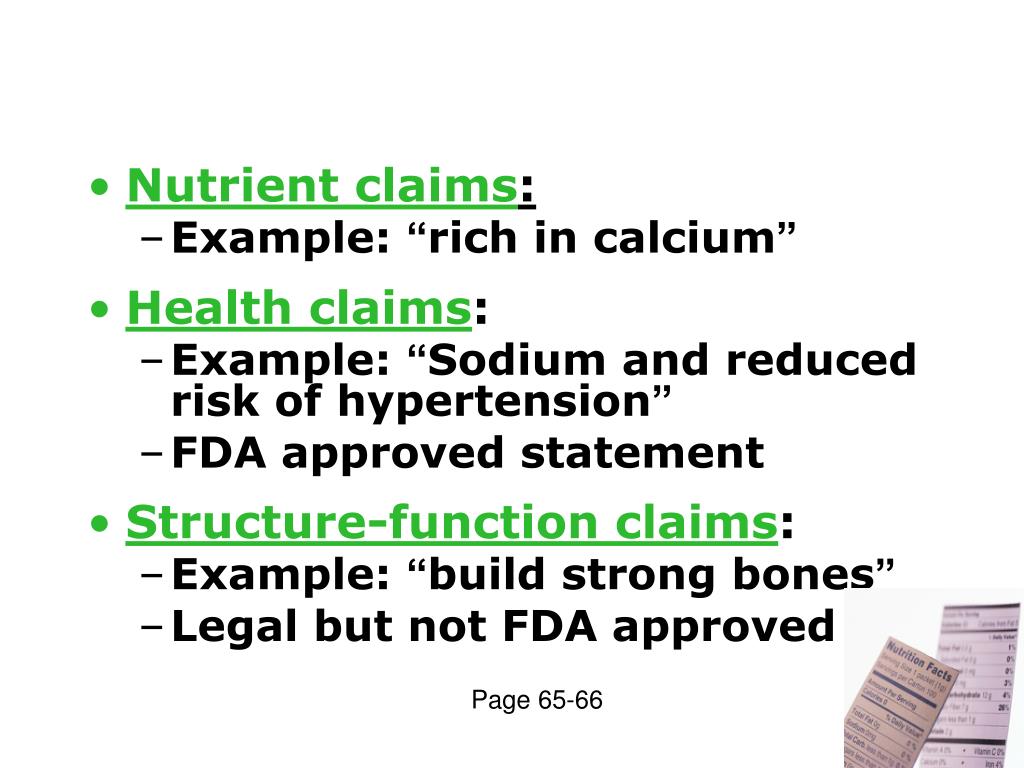

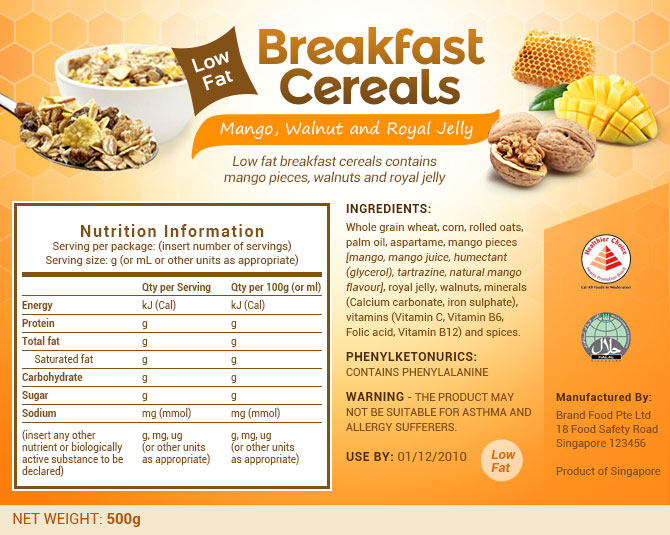




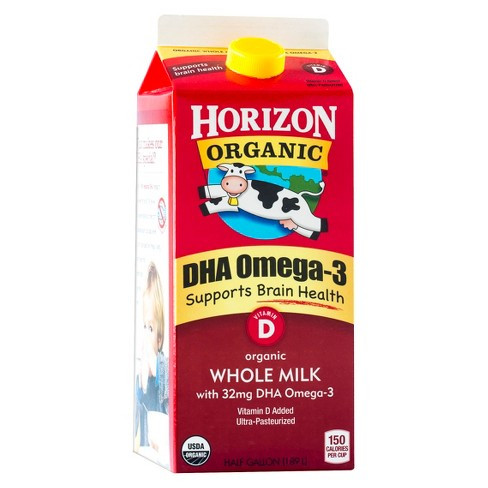
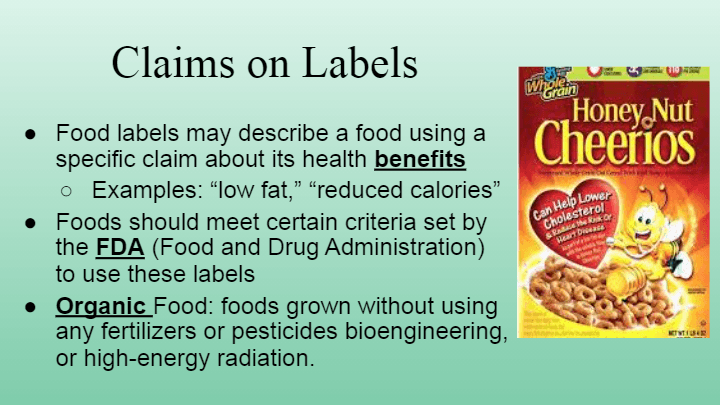

:no_upscale()/cdn.vox-cdn.com/uploads/chorus_asset/file/3650624/quakerlabel-shelf.0.jpg)




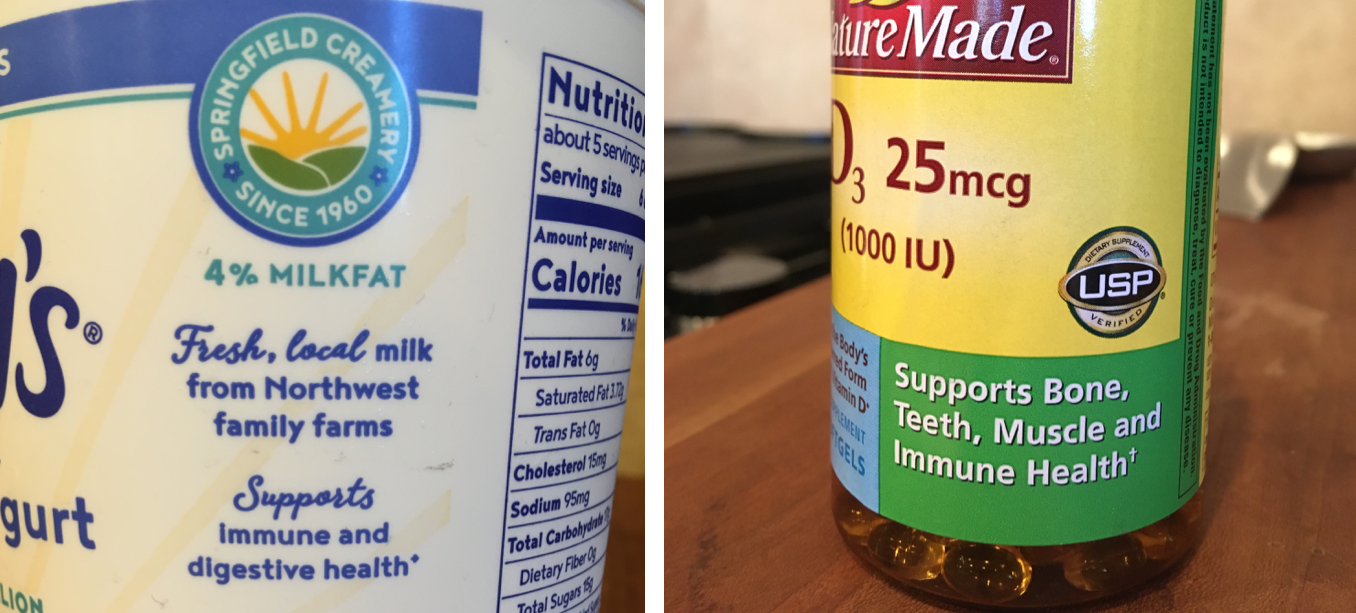
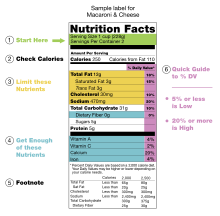





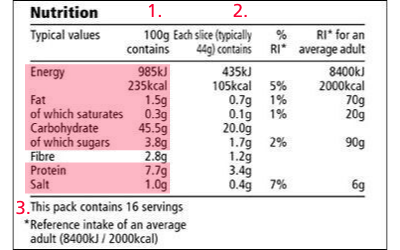
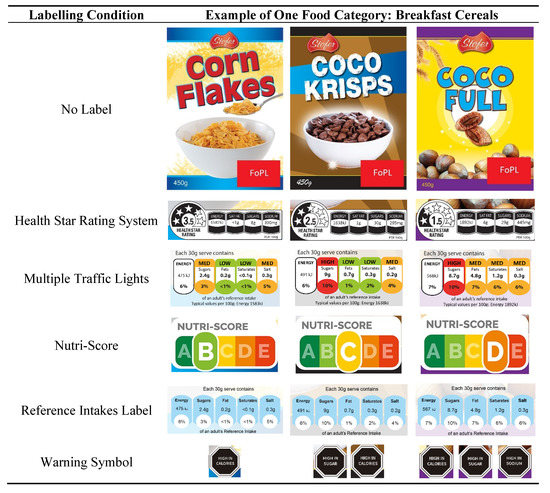





Post a Comment for "42 examples of nutrient claims on food labels"